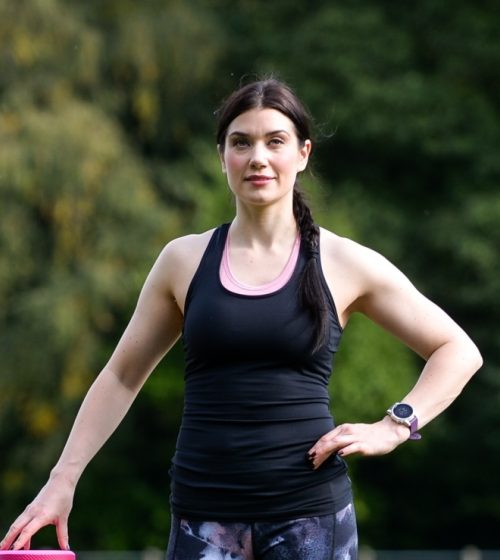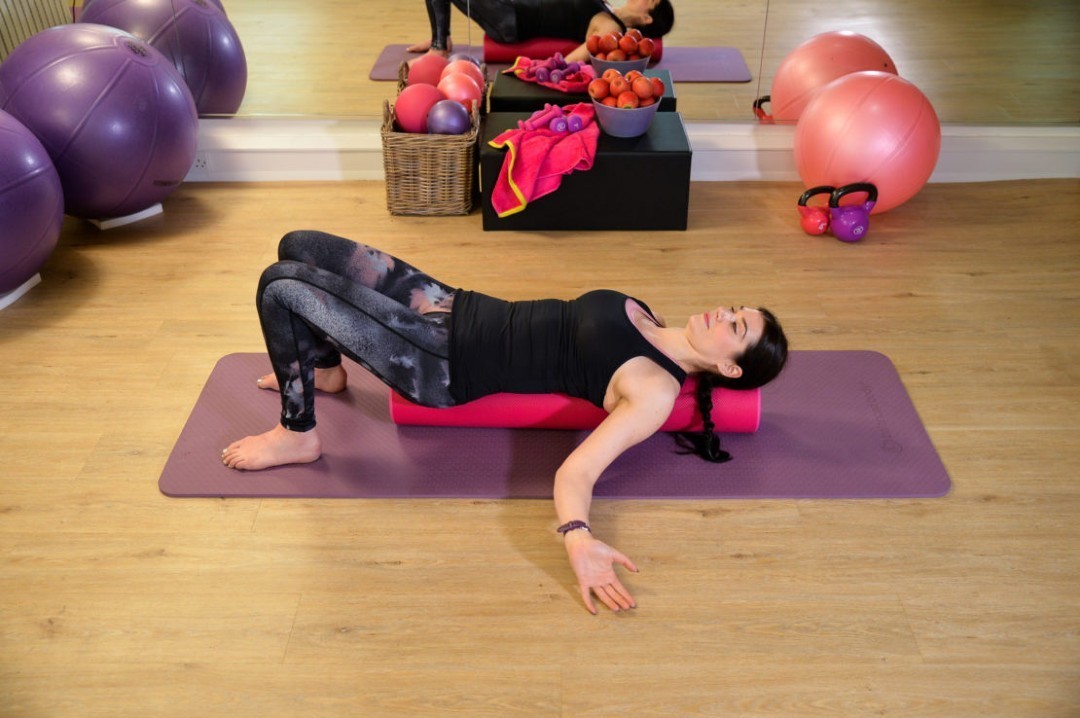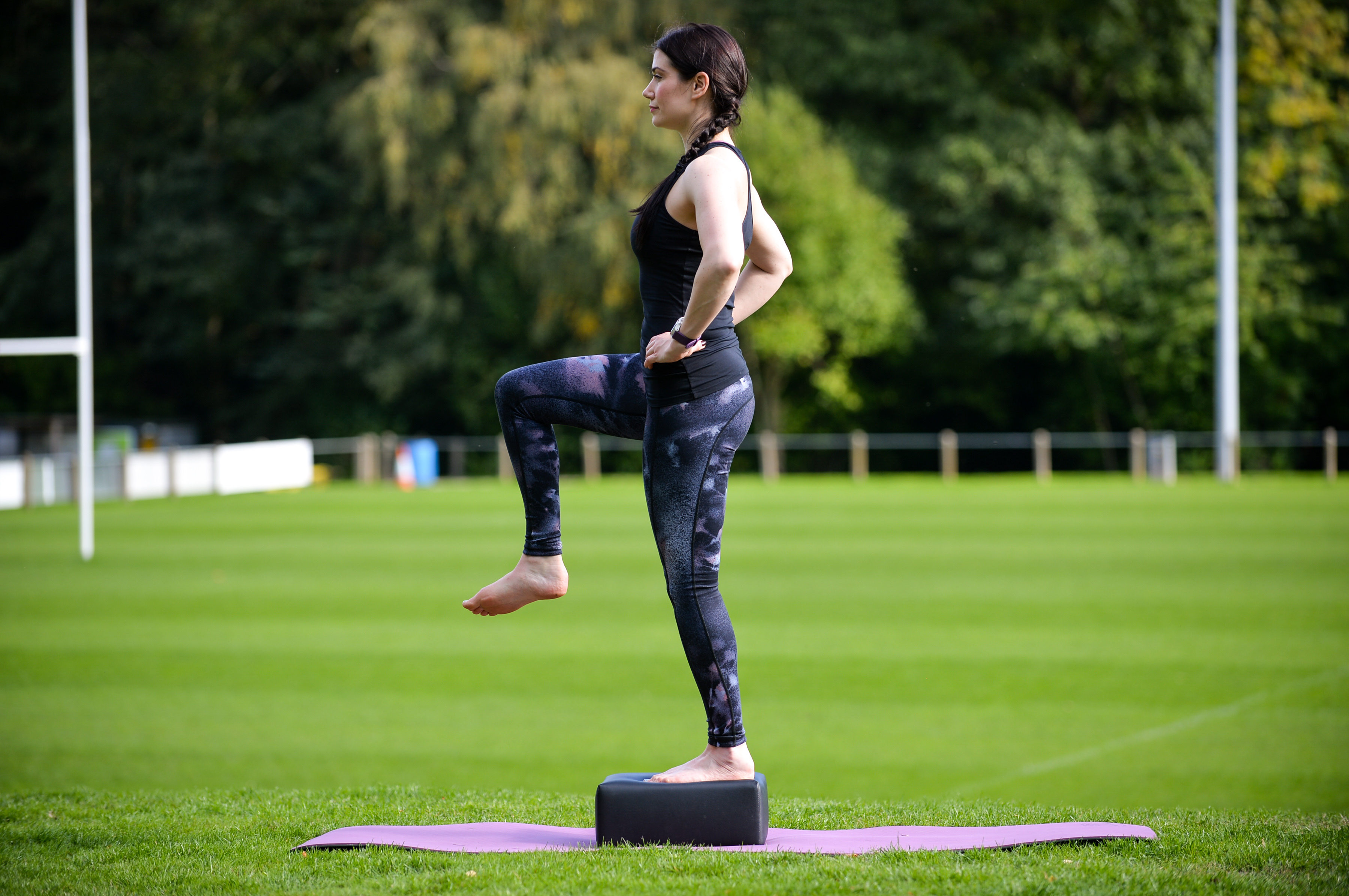
Core-Series 6
Series 6
In Pink Lady® Core series 6, Pilates instructor and certified personal trainer, Jane Linden-Brown, is demonstrating how to combat those everyday strains we put on our body. Jane’s functional fitness exercises will help those suffering from poor back posture, knee pain triggered by stairs and back strain from lifting heavy objects.
Why functional fitness?
We often think of strength in terms of bulging muscles and lifting large weights, so it’s easy to assume that you need to hit the gym to develop core strength, but that’s not the case. Functional fitness exercises train your muscles to work together and prepare them for daily tasks by simulating common movements you might do at home, at work or in sports. These exercises engage your core and body weight through low-impact workouts that engage your muscles in an efficiently strong but gentle way, requiring you to use new breathing techniques and movements that truly re-shape your body.
Problem 1 - Back Posture
Problem 2 - Knee Pain
Problem 3 - Lifting Objects Back Strain

Pink Lady® Core: Back Posture
Combat those everyday strains with Pink Lady® Core
Pink Lady® has teamed up once again with Pilates instructor and certified personal trainer, Jane Linden-Brown, the creator of Pink Lady® Core. In this new Pink Lady® Core series, Jane explores how functional fitness can combat those everyday strains.
After identifying three physical strains we all experience, Jane used her sixteen years’ worth of knowledge and expertise to provide Pilates exercises to help overcome everyday challenges.
Why functional fitness?
With bulging muscles and lifting large weights often mistaken for strength, it’s easy to assume that you need to hit the gym to build up muscle to help your core. Functional fitness exercises train your muscles to work together and prepare them for daily tasks by simulating common movements you might do at home, at work or in sports. These exercises engage your core and body weight through low-impact workouts that engage your muscles in an efficiently strong but gentle way, requiring you to use new breathing techniques and movements that truly re-shape your body.
How to combat poor back posture
If you work in an office, sit at a desk all day or spend quite a lot of time gazing at your phone, you may slouch causing back pain. Make your long days more comfortable with the following exercises from Jane to help improve your posture.
Exercise one: Chest openers
This exercise lengthens the muscles that are commonly tight due to poor posture. If the chest and shoulder muscles are excessively tight they can contribute towards pulling the upper body forwards. Over time this can lead to over-lengthening and weakening of the middle and upper back muscles.
- Place the foam roller lengthways on the mat, then with your feet parallel on the ground, lie your back and head carefully onto the foam roller. Raise both your arms straight towards the ceiling.
- Open your arms away from each other, slowly lowering your arms in line with your shoulders straight towards the floor with your palms facing towards the ceiling. Feel a stretch across your chest as you breathe in. Exhale and lift your arms back to the start position. Repeat five or six times.
- Next, bend your elbows to create a wide W shape with your arms. Keeping the backs on your hands on the floor, straighten your arms above your head, feeling the healthy stretch across your chest and shoulders.
- Return to the start position again, keeping your hands on the floor. Repeat four times before raising your arms straight towards the ceiling.
- Lower your arms slowly and rest.
Exercise two: Back bends over a foam roller
Back bends over a foam roller or ball improves the mobility of the thoracic spine to move backwards. This ability of the spine to move backwards is reduced with age, but it can also be reduced due to a modern-day posture.
- Place your foam roller horizontally across the top of your mat. With your feet parallel on the ground, lie back with the foam roller level with your shoulder blades supporting your upper body, while using your hands to support your head.
- Slowly and gently bend your upper spine over the roller without tipping your head back or lifting your chin. Let your hands to support your head. Use the strength of your tummy muscles to support your spine and try to keep your lower back still.
- Exhale and use your abdominals to curl back up to your starting position.
- Slowly repeat four times and then rest.
Exercise three: Swan
The swan strengthens the back extensors and deep middle back muscles which are often under-utilised and weakened due to bad posture.
- Place your foam roller horizontally across the top of your mat. Gently lie with your front on the mat.
- Place your arms above your head with your palms resting on the foam roller.
- Tuck your pelvis under and lift your chest gently from the floor letting the roller support your arms as you pull it towards you, stopping at your fingertips. Keep your head and neck in a neutral position and try to open your chest and shoulders.
- Gently roll back to your palms, lowering your chest, repeat four times and then rest.
Want to learn more ways to overcome our everyday aches and pains? Stay tuned for more functional fitness with Pink Lady®Core.

Pink Lady® Core: Knee pain
In our current Pink Lady® Core series, Pilates instructor and certified personal trainer, Jane Linden-Brown, is demonstrating how to combat those everyday strains we put on our body. Having revealed functional fitness exercises that will help those suffering from back strain [insert link], Jane is now showing us exercises that will help to combat knee pain triggered by stairs.
Why functional fitness?
We often think of strength in terms of bulging muscles and lifting large weights, so it’s easy to assume that you need to hit the gym to develop core strength, but that’s not the case. Functional fitness exercises train your muscles to work together and prepare them for daily tasks by simulating common movements you might do at home, at work or in sports. These exercises engage your core and body weight through low-impact workouts that engage your muscles in an efficiently strong but gentle way, requiring you to use new breathing techniques and movements that truly re-shape your body.
How to combat knee pain triggered by stairs
Knee niggles are something many of us struggle with, whether it’s while we’re walking and running, or climbing the stairs. Knee pain can be a symptom of many different conditions. Please seek medical advice if your problem is severe or if it persists.
You’ll need:
- Pilates or yoga mat
- Foam roller or bannister
- Block or step
Exercise one: Standing knee folds
Standing knee folds improve your balance, which is an important part of functional movement. Balance is part of everything we do and begins in your core. Activities such as walking and going up and down the stairs are balance exercises as they engage your core, which is not only your abdomen but also gluteal muscles (the ones in your bottom).
Standing on one leg requires a lot of core and hip control. Strengthening these muscles will reduce the risk of injury in everyday life.
- Place your feet parallel and hip distance apart.
- Place your hands on your hips using your fingertips to make yourself aware of any movement of your hips – the goal is to ensure that the level of your pelvis is maintained throughout the exercise.
- Slowly raise your right leg, bending at the knee and lower. Repeat on the other side.
- Repeat eight to ten times and then rest.
Exercise two: Standing hip hike
If you can balance on one leg, the standing hip hike is a great exercise to help you strengthen the gluteus medius muscle. This muscle helps maintain a normal walking gait and reduces the likelihood of ankle, knee and hip injuries.
- Stand alongside a block or step with your feet parallel and hip-distance apart.
- Place one foot onto your block or step and then, while using a bannister or foam roller for support, raise the other foot off the ground so your feet are level
- Slowly lower your hovering foot by dropping your hip, keep your legs straight and don’t twist at the waist. Use the muscles in your waist and hip to hitch the hip of your hovering foot up, lifting your foot a little higher than the block, then lower it back to the starting position.
- Repeat four times.
- Switch sides and repeat.
Exercise three: step up
Step up, as the name suggests, is a progression exercise from the previous two exercises. Step up is much more dynamic and requires core and hip control. It further strengthens the hip muscles, as there is a greater challenge of load through the hip muscles. The goal is to maintain correct alignment of the ankle, knee and hip whilst maintaining a level pelvis.
- Face towards a block or step with your feet parallel and hip-distance apart. Place your hands on your hips or place one hand on a bannister for extra support. The aim throughout this exercise is to keep your hips level and to engage those glutes – the muscles in your bum.
- Keeping your hips level and facing forwards and your right leg straight with the foot planted firmly on the floor, lift your left foot bending at the knee and hip and place it on the block.
- Push into your left heel and use the strength of your glute to step up onto the block with your right foot and then slowly lower back onto the ground landing softly. Repeat four times.
- To go a step further, as you step up bring your right leg through to balance on the block on your left foot, with your right knee at hip height, bent at 90 degrees. Lower your foot to the ground behind you slowly and repeat four times and then return to your starting position.
- Repeat on the other side, then rest.

Pink Lady® Core: Back strain from lifting heavy objects
In this final installment of Pink Lady® Core series 6, Pilates instructor and certified personal trainer, Jane Linden-Brown, demonstrates functional fitness exercises to combat back strain that occurs when lifting heavy objects.
Why functional fitness?
We often think of strength in terms of bulging muscles and lifting large weights, so it’s easy to assume that you need to hit the gym to develop core strength, but that’s not the case. Functional fitness exercises train your muscles to work together and prepare them for daily tasks by simulating common movements you might do at home, at work or in sports. These exercises engage your core and body weight through low-impact workouts that engage your muscles in an efficiently strong but gentle way, requiring you to use new breathing techniques and movements that truly re-shape your body.
How to combat back strain from lifting heavy objects
Whether we’re carrying large bags of groceries or a laundry basket filled with clothes, we all risk creating back strain when lifting heavy objects. It’s important to strengthen and stabilise the spine so that we can take on these everyday tasks comfortably and without doing any damage to our bodies.
You’ll need:
- A resistance band
- Barre or bannister
- Pilates or yoga mat
Exercise one: Standing plank with band
The standing plank with a band is an anti-rotation exercise. The goal is to resist the rotational force that the band places on the spine, which will help to build stability and strength of the spine.
- Loop your resistance band through your barre or bannister to anchor it.
- Stand at 90 degrees to the barre or bannister with your feet parallel and hip distance apart.
- Pick up the band and hold it securely in both hands. Keeping your back straight turn your body to face straight forward. You will need to stretch the band and work your core muscles in order to hold it still in front of your chest bone. Try to keep your back in its natural curves throughout and your feet still. If it feels too easy, step further away from the anchor point.
- Slowly extend your hands forward to straighten your arms, and then return your hands to your chest.
- Repeat this movement three or four times, then return the band to the barre or bannister and rest.
Exercise two: Superman
Like the previous exercise, the superman is an anti-rotation and spine stability exercise. It also challenges shoulder stability and balance, making it a little trickier than the previous exercise.
- Position yourself on all fours on the mat, with your knees bent, legs hip distance apart and your arms straight, and your hands directly under your shoulders.
- Keeping your back straight and your neck and head aligned, extend your left arm forward.
- Then carefully extend your right leg behind you, raising it slowly from the floor.
- Hold for a couple of seconds, trying to keep your spine level and your waist long, before returning to your starting position.
- Next, extend your right arm, followed by your left leg, and hold.
- Repeat three or four times.
Exercise three: plank
The goal of any plank exercise is to maintain the neutral position of the spine against the downward challenge of gravity. A ‘neutral spine’ is the spine in a straight position. A straight spine is the spine in its strongest position, making it less vulnerable to injury. Any plank exercise takes a lot of core control. Having the ability to hold the spine in neutral against a load or gravitational force will reduce the risk of injury and back pain.
- Position yourself on all fours on the mat, with your knees bent, legs hip distance apart and your arms straight, shoulder width apart.
- Extend your legs straight, stepping onto your toes and hold for a few seconds. Use your glutes and abdominals and back muscles to stop your spine from moving away from neutral. You should aim not to arch your lower back or let your ribs drop towards the mat. Build up slowly until you can hold the plank position for 30 seconds.
- Return to your preferred resting position